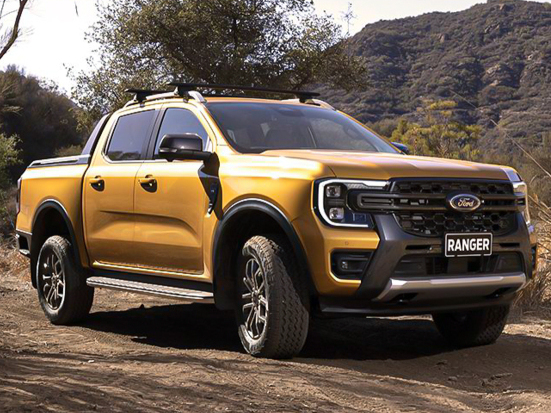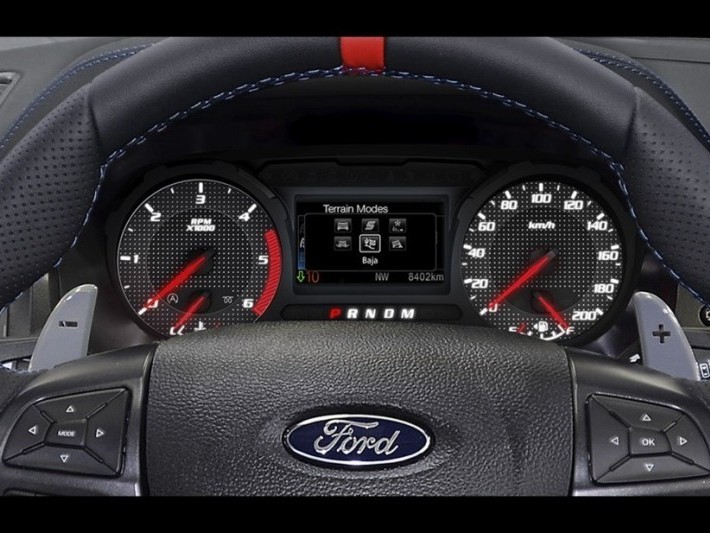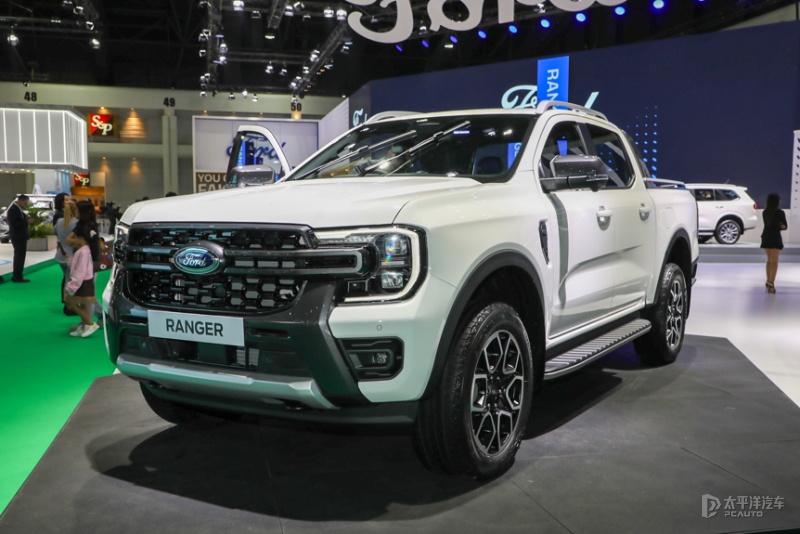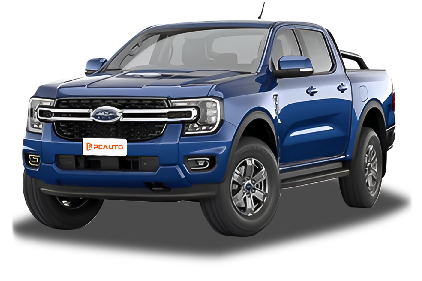Q
How heavy is a 2023 Ford Raptor?
The 2023 Ford Raptor has a curb weight of around 2,615 kilograms, mostly coming from its tough high-strength steel frame chassis, all-aluminum body, and that beastly 3.5-liter EcoBoost V6 engine. For a high-performance off-road pickup, this weight works—it helps boost stability and durability when you're tackling rough terrain. What's cool is that even with that heft, the Raptor still handles pretty well and isn't a total gas guzzler, thanks to lightweight materials and a suspension setup that's been dialed in just right. If you're into off-roading, this weight gives you the security you need without killing the fun factor. And if you regularly haul gear or tow stuff, the Raptor's max payload and towing capacity are seriously impressive—definitely up to all kinds of practical tasks. It's that rare truck that blends performance and utility like a pro.
Special Disclaimer: This content is published by users and does not represent the views or position of PCauto.
Related Q&A
Q
What is the V6 engine in the Raptor 2023?
The 2023 Ford Raptor is powered by a 3.5-liter EcoBoost twin-turbocharged V6 engine, renowned for its impressive power delivery and fuel efficiency. It cranks out 450 horsepower and 691 Nm of peak torque, paired with a 10-speed automatic transmission that delivers robust acceleration and off-road capability. The V6 design maintains strong power output while being lighter than a traditional V8, enhancing overall vehicle handling and fuel economy. This engine also features advanced turbocharging tech and direct injection, churning out ample torque at low revs—perfect for both off-roading adventures and highway cruises. For performance truck enthusiasts, the Raptor's V6 doesn't just handle daily drives; it excels in tough terrain with outstanding capability. Plus, the turbocharging setup strikes a solid balance between eco-friendliness and performance, keeping up with modern automotive tech trends.
Q
How does the 2023 Raptor compare to the TRX?
The 2023 Ford F-150 Raptor and Ram 1500 TRX are both icons of high-performance full-size pickups, but their design philosophies and performance focuses set them apart. The Raptor packs a 3.5L EcoBoost V6 twin-turbo engine with 450 horsepower, emphasizing high-speed off-road capability and lightweight construction. It comes with upgraded FOX Live Valve dampers and a smarter terrain management system, making it ideal for long-distance trail runs and complex landscapes. The TRX, on the other hand, rocks a 6.2L supercharged Hemi V8 cranking out a beastly 702 horsepower, prioritizing straight-line acceleration and extreme off-road dominance. Equipped with Bilstein Black Hawk e2 adaptive shocks, it’s more for folks chasing raw power and old-school rugged off-roading. Inside, the Raptor leans into utility and tech, standard with a 12-inch touchscreen and SYNC 4, while the TRX ups the luxury ante with suede seats and premium audio. Neither is a fuel sipper, but the TRX’s V8 definitely drinks more. Choosing between them boils down to your needs: the Raptor suits those who love bombing through deserts and want balanced performance, while the TRX is the go-to for max horsepower and that classic American muscle vibe. Also, keep in mind road adaptability if you’re using these high-performance trucks locally—their wide bodies and off-road suspension can feel a bit clunky around town.
Q
How much horsepower does a 2023 Raptor have?
The 2023 Ford Raptor comes with a 3.5-liter EcoBoost V6 twin-turbo engine, cranking out 450 horsepower and 691 Nm of peak torque, mated to a 10-speed automatic transmission. It’s got some serious muscle, perfect for off-roading and high-speed driving. This truck also packs an advanced 4WD system and terrain management system, making it a breeze to handle all kinds of tough road conditions. If you’re into high-performance pickups, the Raptor’s a solid choice—it’s not just powerful, but also has great suspension tuning and off-road chops, plus it’s pretty comfortable for daily driving. On top of that, the EcoBoost tech balances power and fuel efficiency; sure, it drinks more than regular models, but it’s actually pretty reasonable for a performance truck in its class. And if you need even more grunt, there’s the Raptor R, which rocks a 5.2-liter supercharged V8 with over 700 horsepower—though it’ll cost you more upfront and at the pump.
Q
Does the 2023 Raptor have self-driving?
The 2023 Ford Raptor doesn't come with full self-driving capability, but it does pack some advanced driver-assistance systems. Think adaptive cruise control, lane-keeping assist, and automatic emergency braking—stuff that can give you a semi-automated driving experience under certain conditions. Important to note, though: these systems still need the driver to stay focused and ready to take over at any time to keep things safe. A lot of high-performance pickups and SUVs on the market these days have similar driver-assistance tech, but it's all designed to cut down on driver fatigue, not replace the person behind the wheel. If you're into autonomous driving tech, keep an eye on some of the newer electric vehicle brands—they tend to pour more R&D into automated driving. But even the fanciest systems out there are still in the limited-condition, driver-assist phase. Fully self-driving cars still have a long road ahead, both in terms of regulations and technology.
Q
How much horsepower does a 2023 Ford Ranger Raptor 3.0 V6 EcoBoost have?
The 2023 Ford Ranger Raptor's 3.0-liter V6 EcoBoost twin-turbo engine cranks out 392 horsepower and 583 Nm of torque, a massive step up from the previous gen's 2.0-liter four-cylinder. This high-performance pickup also rocks a 10-speed auto transmission and full-time 4WD system, balancing off-road capability with on-road manners. EcoBoost tech pairs turbocharging with direct injection to boost fuel efficiency while ramping up low-end torque, making it solid for any terrain. Plus, it gets exclusive setups like Baja mode, FOX 2.5-inch live valve shocks, 283mm of ground clearance, and 850mm water fording depth—all of which keep it handling like a champ on high-speed gravel or rough trails. If you're after a top-tier off-road experience, this one's definitely worth a look.
Q
How much horsepower does a 2023 Ranger have?
The 2023 Ford Ranger comes with a variety of powertrain options, with specific horsepower outputs depending on the engine configuration. The most powerful version is equipped with a 2.0-liter four-cylinder twin-turbo diesel engine, delivering 210 horsepower and 500 Nm of torque, ideal for users needing strong performance. The entry-level model, on the other hand, features a 2.0-liter single-turbo diesel engine, providing 170 horsepower and 405 Nm of torque, striking a balance between fuel economy and performance. Additionally, some markets offer a 2.3-liter turbocharged gasoline engine option, producing around 270 horsepower, suitable for drivers who prefer petrol power. The Ranger's powertrain has been meticulously tuned to suit not only daily driving but also off-road and load-carrying needs. Its 10-speed automatic transmission further enhances power delivery smoothness and fuel efficiency. If you're interested in pickup trucks, you might also want to check out other models in the same class, each with its own strengths in power, cargo capacity, and tech features. It's advisable to test drive and compare based on your actual needs before making a decision.
Q
What transmission is in the 2023 Ford Ranger?
The 2023 Ford Ranger offers two transmission options based on different powertrain configurations. The 2.0-liter single-turbo or bi-turbo diesel engines are paired with a 10-speed automatic transmission, while the 3.0-liter V6 turbocharged diesel engine comes with an upgraded, more robust 10-speed automatic transmission. Both gearboxes have been specifically tuned to balance off-road capability with on-road driving smoothness. The advantage of the 10-speed transmission lies in its closely spaced gear ratios, which optimize power delivery and improve fuel efficiency, particularly excelling during low-speed climbing or high-speed cruising. It's worth noting that this transmission works in conjunction with Ford's Terrain Management System, automatically adapting to challenging road conditions like sand and mud. For users who frequently need to carry heavy loads or tow, the transmission's built-in Tow/Haul mode provides more abundant torque output by delaying upshifts. In terms of maintenance, it's recommended to check the transmission fluid condition every 60,000 kilometers. If you regularly engage in high-intensity off-roading or towing, the maintenance interval should be shortened, and using the factory-specified transmission fluid is essential to ensure optimal durability.
Q
How much does a brand new 2023 Ford Ranger cost?
The 2023 Ford Ranger's price varies depending on the trim and configuration. The base XL model starts at around RM100,000, while the top-spec Wildtrak could exceed RM160,000. For the latest pricing, it's best to check with your local dealer. This pickup truck is powered by a 2.0-liter turbocharged diesel engine, delivering solid power and fuel efficiency, along with good payload and towing capacities, making it suitable for various road conditions and usage scenarios. The Ranger also comes loaded with safety features, including adaptive cruise control, lane-keeping assist, and automatic emergency braking. As a globally popular midsize pickup, it has a strong reputation for reliability, durability, and off-road capability. Recent upgrades to its exterior and interior have further enhanced its tech feel and comfort, making it one of the top contenders in its class.
Q
Where is the 2023 Ford Ranger built?
The 2023 Ford Ranger is primarily built at the Ford Southeast Asia Manufacturing Center in Rayong, Thailand – a key production hub for Ford in the Asia-Pacific region, supplying multiple markets including the local one. This pickup rides on a global platform, with its chassis tuning and powertrain specifically optimized for Southeast Asian road conditions. Take the 2.0L bi-turbo diesel engine, for example – it balances durability in tropical climates with the need for strong torque output. It’s worth noting that the current Ranger shares some tech with the Volkswagen Amarok but retains Ford’s signature driving feel, with things like the electric power steering and Terrain Management System getting unique calibrations. For owners who love modifying their rides, the body-on-frame construction and robust ecosystem of factory accessories offer solid upgrade potential, from skid plates to bed roll bars – you can find a solution for just about anything. On the after-sales front, authorized dealers across Malaysia provide maintenance support up to Ford’s global standards, including specialized synthetic oils and diagnostic equipment.
Q
What are the maintenance costs for a 2023 Ranger?
The maintenance costs for the 2023 Ranger can vary depending on the specific trim and how you drive it, but generally, basic services like an oil and oil filter change will set you back around 300 to 500 ringgit. That range depends on the type of oil you go for and what the service center charges. If you need a more comprehensive service—think air filter replacement, brake fluid flush, or transmission oil change—you’re looking at 800 to 1200 ringgit instead.
And let’s not forget long-term costs: tires wear out, brake pads need replacing. To keep things running smoothly, I’d recommend a basic check-up every 10,000 kilometers or six months. Trust me, regular maintenance isn’t just about extending the truck’s life—it also boosts fuel efficiency and cuts down on unexpected breakdowns.
If you’re someone who frequently takes your Ranger off-roading or drives on rough terrain, you’ll want to inspect the suspension and 4WD components more often. Those extra checks might add a bit to your maintenance bill, but they’re worth it.
Finally, stick to the official maintenance manual and go to authorized service centers. Using genuine parts and getting professional service is the best way to keep your Ranger in top shape.
Latest Q&A
Q
Does the 2020 RAV4 have transmission problems?
Regarding transmission issues with the 2020 RAV4, there have been no widespread reports or official recalls indicating common faults with this model. The Direct Shift-CVT transmission it comes with has shown stable performance in most user feedback, delivering smooth driving experiences under regular maintenance. However, some owners have mentioned occasional slight jerking at low speeds, which is a common characteristic of CVT architecture rather than a defect. For daily use, it's advisable to regularly replace the transmission fluid (every 60,000 to 80,000 kilometers) and avoid prolonged aggressive driving to extend its lifespan. If you encounter abnormal shifting or unusual noises, promptly visit an authorized service center for inspection—early electronic module or software issues can often be resolved through updates. It's worth noting that unlike traditional AT transmissions, CVTs feature a steel strip-driven design that prioritizes fuel efficiency, making them ideal for urban driving. However, when towing heavy loads or frequent hill climbing, switching to manual mode is recommended to protect components. When buying a used RAV4, test drive to check shifting smoothness and review maintenance records to confirm regular upkeep—these preventive steps effectively reduce potential risks.
Q
How many miles will a 2020 RAV4 last?
Under normal maintenance and care, the 2020 RAV4 can typically hit 200,000 to 300,000 miles, with some owners pushing past that. Its lifespan really comes down to driving habits, road conditions, and how often you keep up with service. The 2.5L naturally aspirated engine and hybrid system are known for durability, and Toyota's build quality and parts reliability back that up for the long haul. Sticking to regular oil changes, transmission fluid swaps, brake fluid replacements, and following the manufacturer's recommended service schedule will definitely help extend its life. It's worth noting that hybrid battery packs usually last around 10 to 15 years, but after replacement, the vehicle can keep going strong. For high-mileage RAV4s, keep an eye on suspension wear, driveshaft condition, and any seal leaks. Day-to-day, avoiding constant hard acceleration or sudden braking also cuts down on mechanical wear. If you want to stay on top of your RAV4's health, regular computer diagnostics or keeping an eye on fuel economy changes can help spot potential issues early.
Q
Is the 2020 RAV4 good in snow?
The 2020 RAV4 performs pretty well in the snow, mainly thanks to its standard Dynamic Torque Vectoring AWD system. This all-wheel drive setup can real-time distribute torque between the front and rear wheels, as well as the left and right rear wheels, boosting grip on slippery surfaces. Plus, it comes with Multi-Terrain Select modes (including a Snow mode) that automatically adjust power delivery and braking logic to handle snow-covered roads. The 215mm ground clearance also reduces the risk of getting stuck on snow, while the standard traction control and vehicle stability systems further enhance safety. It's worth noting that if you frequently use it in freezing regions, swapping to winter tires is recommended because the stock all-season tires don't perform as well in deep snow. The RAV4's AC system has a quick defrost function, which is really helpful for visibility when driving in the snow. Among similar class models, comparable AWD tech is also found in vehicles like the Forester, but the RAV4 has the edge with its better fuel economy. If you only encounter icy or snowy weather occasionally, this system is more than enough, but if you're using it long-term in extremely cold areas, you might want to consider more specialized off-road models.
Q
How much is the 2020 RAV4?
The price of a new 2020 Toyota RAV4 ranges from approximately 180,000 to 220,000 Malaysian Ringgit depending on the trim level, specifically varying by the powertrain option (such as 2.0L or 2.5L) and additional features (like all-wheel drive, advanced driver assistance systems, etc.). This model is widely popular for its reliable powertrain, spacious interior, and strong resale value, making it especially suitable for family users or consumers who frequently drive long distances. As a classic SUV in Toyota's lineup, the RAV4 excels in safety performance, coming standard with active safety technologies such as pre-collision system and lane keeping assist, while also leading its class in fuel efficiency. If considering the used car market, a well-maintained 2020 RAV4 will have a relatively lower price, but it ultimately depends on factors like mileage and service history for a comprehensive evaluation. Prospective buyers are advised to visit authorized dealerships for a test drive to experience the vehicle's handling and comfort firsthand, as well as to get the latest promotional information or financing options.
Q
Are there any problems with the 2020 Toyota RAV4?
The 2020 Toyota RAV4 is generally a reliable SUV, but based on owner feedback and some reports, there are a few common issues to be aware of. For instance, some vehicles might experience fuel pump failures leading to engine stalling – Toyota has issued a recall to replace these pumps. Additionally, a small number of owners have reported dashboard rattles or infotainment system lag; these minor electronic issues can often be resolved with a software update or wiring harness check. Hybrid models occasionally trigger the hybrid system warning light, which usually just requires a system reset or battery cooling inspection. The RAV4's 2.0L and 2.5L engines are well-proven, and for daily maintenance, using 0W-20 full synthetic oil is recommended to optimize performance. Its TNGA platform chassis offers noticeably better handling than the previous generation, though the suspension tuning is on the firmer side – it's advisable to slow down when going over speed bumps to avoid discomfort. The car's active safety systems like pre-collision and lane keeping perform consistently in real-world driving, though the rain-sensing wiper sensitivity might need manual adjustment based on local climate conditions. Overall, as long as you follow the official recommended maintenance schedule and stay updated on recall information, this vehicle's durability is trustworthy, and it also holds relatively good resale value in the used car market.
View MoreRelated News

2025 Ford Ranger WildTrak launched, the most powerful diesel version in the Ranger lineup
MichaelAug 25, 2025

Is the Ford Ranger V6 about to enter Malaysia?
LienAug 13, 2025

Reviewing the Ford Ranger: The Dual Advantages of Rugged Appearance and Powerful Performance
Kevin WongApr 21, 2025

"Starting from RM 170,888! Detailed Explanation of Ford Ranger's Configuration and Performance, a Synonym for Practicality and Versatility?"
AshleySep 20, 2024

Ford Ranger: A Safe, Reliable, and Economical Choice of Pickup
LienMay 2, 2024
View More


















Pros
Cons